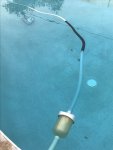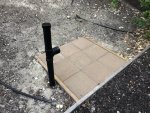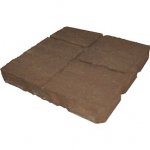We can't rule out that the vac is defective in some way, but based on your description I would first troubleshoot the flow rate it is getting. Your vac should have come with a set of instructions or a flow indicator, or both, that help you determine the optimum flow for your vac. Mine came with both. I'll describe how mine works, apply as appropriate.
My flow indicator is a small plastic tube that fits inline with the vac's hose. It has a small lever that reacts to the water flowing through the hose and tube, and a printed scale that lets you know when the flow is within optimal range. It is then a simple matter to adjust your pump's RPM to achieve optimal flow through the vac. So step one is to find out if the manufacturer of your vac supplies such a thing, and if so get a hold of it.
If that doesn't solve the vac's performance issue, the next best solution is to see if the vac's manual includes instructions for determining optimal vac performance based on the vac's wheel's RPMs. Something along the lines of x rotations per minute, or x seconds per rotation. Find those instructions and adjust your pump's RPMs to achieve the optimum vac wheel RPM. If the instructions don't include such instructions, call the manufacturer and inquire of their support staff for instructions like that.
If neither of those get you some good vac performance, then your setup might be suffering from what my setup was. As long as I tried to run both my vac and my skimmer at the same time, I couldn't get either to work well. Both were plumbed to a three-way valve at the pad, to allow me to balance flow between the two, but I could never get it right. Either the vac worked well(ish), or the skimmer did, but never both. And even if I could have, the skimmer's performance was not static because sometimes it would be full of leaves (affecting flow) and other times not. So I installed an actuator on the three-way valve and programmed the valve to go back and forth between skimmer and vac. That solved the performance of the vac, because it was getting most of the suction of the pump*, and then when in "skimmer mode," the skimmer's performance was also greatly improved. The schedule is controlled by my pool's automation system. So that's my recommended solution.
But there's more! (There always is...)
A suction-side vac, run the way you're running yours, is somewhat of a hazard. It's an exposed suction port that you are allowing in your pool during swimming hours. While it's arguably less dangerous than an exposed main drain's suction, it is still an exposed suction port, and one that does not have any sort of protective cover. The suction hole under the vac is fully exposed (mine is, anyway). Could it trap a child underwater? Personally, I'm not going to test that on my long-haired granddaughter who loves to swim down to the bottom. So...
Now that I have a vac cycle that can be scheduled, I run it in the middle of the night, when no one is swimming. And then the actuator closes off that suction port (and its hazard) for the rest of the daylight hours. That also improves energy efficiency, because the RPMs needed for a good vac session are much higher than my daylight skimming RPMs. So the vac only runs 1.5 hours a night, and then the pump drops down to skimming RPM the rest of the day.
Still more!!
* Because I remove the vac and its hose when it's more than just me in the pool (kids!), I have to remember to put it back in the pool after the kids are done. Otherwise, the suction port's spring-loaded flap will deadhead the pump during the vac's nighttime session. I solved for this in two ways: my home automation system alerts me when I have to reconnect the vac, and repeats the alert, all evening, until I do it. More importantly: I adjusted the three-way valve/actuator to allow some flow through the skimmer during "vac mode." Like 20%/80% or something like that. This safety "feature" accomplishes two things: if I ever forget to reconnect the vac, and the vac session occurs, my pump won't deadhead because some amount of flow will still be allowed through the skimmer. And should my vac ever inadvertently come on during daylight hours with people in the pool, and somehow get stuck to someone because they're messing around with it underwater (not all that farfetched given my middle one's tendency to do things he's not supposed to be doing), the vac is less likely to eviscerate him because the entire force of the pump will be relieved by the flow through the skimmer: not unlike the principal that two main drains are safer than one.
Hope that all makes sense. So that took me about a year to figure all that out (almost as long as it took to write this post). But now I've got optimized flow through the vac and the skimmer and a very clean pool. Because I also have a FlowVis in my system, I noted what the system's flow is during an optimal vac run. And my FlowVis makes it a very simple matter to check system flow throughout the year. Why? Because I only clean my filter once a year. As it clogs up, the flow drops slightly, which affects the performance of my vac (and other things, too, like my solar heating system). I maintain optimal flow for everything by slightly adjusting my VS pump's RPMs a few times a year, then reset it in the Spring when I clean my filter, and start over again. So my vac always works as well as it can, all year long...
Whew! Hopefully you'll be able to make use of some of these tips...






